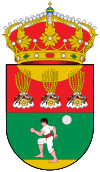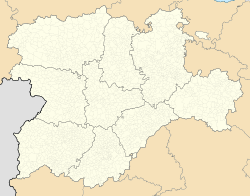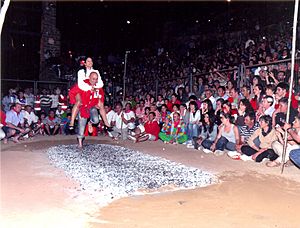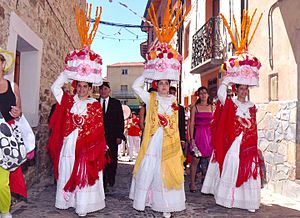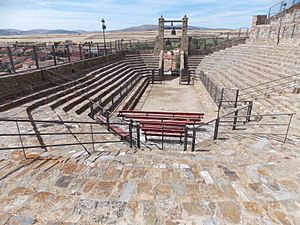San Pedro Manrique facts for kids
Quick facts for kids
San Pedro Manrique
|
||
|---|---|---|
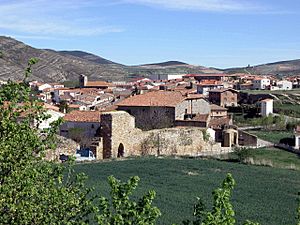 |
||
|
||
| Country | Spain | |
| Autonomous community | ||
| Province | ||
| Comarca | Tierras Altas | |
| Area | ||
| • Total | 176.20 km2 (68.03 sq mi) | |
| Elevation | 1,177 m (3,862 ft) | |
| Population
(2018)
|
||
| • Total | 617 | |
| • Density | 3.5017/km2 (9.069/sq mi) | |
| Time zone | UTC+1 (CET) | |
| • Summer (DST) | UTC+2 (CEST) | |
| Climate | Cfb | |
San Pedro Manrique is a small town in the province of Soria, located in the region of Castile and León, Spain. As of 2018, about 617 people live there. Since the mid-1800s, this town has grown by adding smaller villages nearby. There is also a lead deposit in the area.
Contents
Villages in San Pedro Manrique
San Pedro Manrique includes several smaller villages. These are:
- Acrijos
- Armejún
- Buimanco
- Fuentebella
- Vea
- Peñazcurna
- Valdemoro de San Pedro Manrique
- Villarijo
- Matasejún
- Valdelavilla
- Santiago
- Valdenegrillos
- El Vallejo
- Taniñe
- Las Fuentes de San Pedro
- Ventosa de San Pedro
- Palacios
History of the Town
For a long time, until the French Revolution, San Pedro Manrique was a town in the region of Castilla la Vieja. In 1842, a count showed that the town had 138 homes and 550 people living there.
During the 1800s, the town grew bigger. It added several nearby villages like Acrijos, Armejún, Buimanco, Fuentebella, Peñazcurna, Valdemoro de San Pedro Manrique, and Villarijo.
Later, in the late 1900s, even more villages joined. These included Matasejún, Valdelavilla, Sarnago, Valdenegrillos, El Vallejo, Taniñe, Las Fuentes de San Pedro, Ventosa de San Pedro, and Palacios. By January 1, 2010, the population was 639 people.
Economy and Jobs
The town is well-known for its tasty spicy sausage. The main ways people earn a living here are:
- Raising animals (livestock)
- Farming (agriculture)
- Making food, especially meat products
- Working in hotels and restaurants (hospitality)
- Forestry (working with trees and forests)
- Providing local services for the community
Unique Festivals and Culture
San Pedro Manrique is famous for its special celebration of the Día de San Juan (Saint John's Day).
The Móndidas
During this festival, some women, called "móndidas," wear traditional clothes. They carry large baskets called "cestaños." These baskets are filled with stones to make them stable. They also hold a special rolled cake and several bread rolls. The baskets are decorated with flowers and three "arbujuelos," which are tree branches covered with saffron-colored bread.
The Paso del Fuego
On the night of San Juan, there is a unique event called the Paso del Fuego (Firewalking). A large bonfire is lit near the Shrine of the Virgen de la Peña. Once the fire has burned down to glowing embers, local people take off their shoes. They then walk barefoot across the hot embers.
It is thought that these festivals might come from very old pagan celebrations that happened before Christianity. The name "móndida" might even come from "Maenad," who were followers of a Greek god. The government of Castile and Leon has recognized this event as an important cultural tradition.
In 2011, a scientific study about firewalking gained worldwide attention. Scientists found that the heartbeats of the firewalkers and the people watching them became synchronized during the ritual.
Important Landmarks
- Shrine of the Virgen de la Peña: This is a very old and important religious building.
- Romanesque Church of San Miguel: This church is built in the Romanesque style and features statues of the Apostles.
Images for kids
See also
 In Spanish: San Pedro Manrique para niños
In Spanish: San Pedro Manrique para niños


